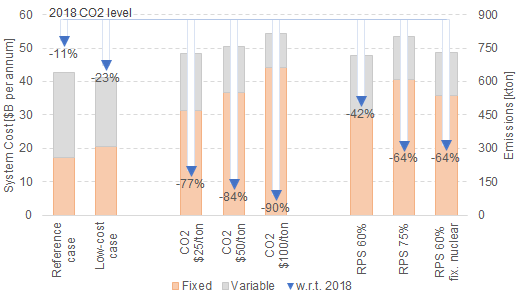CEEPR Working Paper 2021-011, July 2021
Pablo Duenas-Martinez, Karen Tapia-Ahumada, Joshua Hodge, Raanan Miller, and John E. Parsons
This study examines the situation across the U.S. midcontinent, encompassing a set of power systems stretching from Ohio in the east to the plain states in the west, and from Minnesota in the north to Louisiana in the south. We focus on a near-term horizon of 2030, where the tradeoffs are between already commercially available technologies utilizing the existing transmission grid. We use a capacity expansion and dispatch model configured to examine the task of serving the fluctuating hourly load throughout a full year given the fluctuating availability of renewable resources. With it, we explore the impact of decarbonization on the generation mix, operations, and costs.
Many forces have already been transforming generation supply stacks across the region, including the low price of natural gas, the falling cost of renewables, especially wind power, tax incentives and other public support for renewable investments, and tightened air pollution regulations. Stagnant power demand has kept wholesale prices low. Many coal and nuclear assets have taken hits to their valuations. Some have been retired early and more may be retired in the coming years.
We first examined how the generation mix might continue to change in the absence of any further policies. To do so, we parameterized the model with a set of forecasted investment and operating costs for generation technologies taken from the National Renewable Energy Laboratory’s Annual Technology Baseline exercise, and a set of fuel cost projections from the U.S. Energy Information Administration’s Annual Energy Outlook.
The results show a continuation of recent trends producing a limited 11% emission reduction relative to the 2018 simulation. At the system level, fossil fuel-fired capacity of all types decline, but coal and natural gas-fired plants remain the two largest categories of capacity. A small amount of nuclear capacity is retired, too. New investments are large in both wind and solar capacity with solar accounting for more than 2/3 of the added capacity.
We then examined mixes of capacity that achieve substantial emission reductions cost-efficiently. For example, we find that a 77% reduction is achievable by any suite of policies that is comparable to pricing carbon at $25/t CO2. The source of emission reductions is an enormous substitution of coal generation with a mix of natural gas, wind and solar generation and by avoiding the closure of existing nuclear. Natural gas capacity and generation are higher than in the Reference Case. Deeper emission reductions require marching up a steepening marginal cost of abatement curve. We get an 84% and a 90% reduction at a $50 and a $100/t CO2 price, respectively.
Finally, we considered alternative policy direction that focuses exclusively on expanding renewable generation. This is not cost-efficient. It achieves more modest emission reductions at a higher system cost. In our modeling, a 75% RPS produces a 64% emission reduction while raising the annual system cost by $5 billion, a 10% increase.
One source of the inefficiency is a failure to target the most carbon intensive plants for shutdown. Relative to the cost efficient policy, it has more coal generation and less natural gas generation.
A second source of the inefficiency is its impact on nuclear generation. The entire nuclear fleet is retired, sacrificing 256 GWh of zero-carbon generation.
The paper also analyzes how the changing generation mix produces changes to operating profiles and market outcomes. One is a shift in the utilization of fossil plants away from provision of baseload towards balancing fluctuating renewable resources. The fleet capacity factor declines with decarbonization. At the same time, these fossil plants are critical during a few hours to guarantee the reliable delivery of electricity. In fact, in our modeling, we observe investments in gas power plants in light of this need for flexibility.
We also report added volatility to the marginal cost of electricity, a metric that is sometimes used as a proxy for the wholesale energy price. Under deeper decarbonization scenarios, the extreme tails of the distribution grow—benchmarked by $0/MWh at the low end and $100/MWh at the high end. The trend is more marked in those regions with the higher concentration of renewables and where congestion is greatest.

Figure 1. System-wide emission reductions relative to 2018 and average annual system costs across eight scenarios.
References
Duenas-Martinez, P., K. Tapia-Ahumada, J. Hodge, R. Miller, and J. E. Parsons (2021), “Challenges and Opportunities for Decarbonizing Power Systems in the US Midcontinent.” MIT CEEPR Working Paper 2021-011, July 2021.




